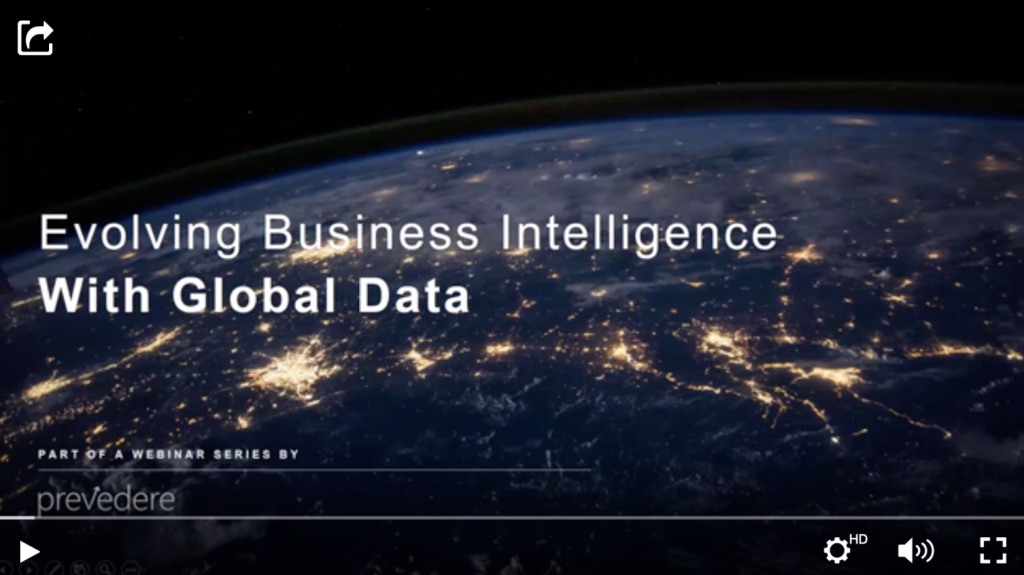Last Updated: April 10, 2020
With all the recent advances in analytics, evolving business intelligence using global intelligence is an assumed best practice. Consensus is that business intelligence using global data is seen as a more holistic and forward-looking view of business performance.
Business Leaders Have Evolved in Their Capacity to Consume and Analyze Data
The way brands are viewing data has shifted from merely collecting it to how to leverage it most effectively.
Gartner has seen a dramatic increase in the use of external data, for example. With sources including partners, customers, and suppliers, as well as open data sets and syndicated data, a vast amount of external data is out there. The real trick is getting business leaders to become more literate, or “info-savvy.”
In the past, the discussion might have been an IT-focused one. Now it is business-focused, says Microsoft. For example, if a company wants to be able to predict which new markets it should consider, that is not a question IT will be able to answer.
Executives now need to be able to look at the data and determine solutions. It helps if they are data literate and can scan the analytics to find the information they need.
During a Prevedere webinar, “How to Evolve Business Intelligence with Global Data,” industry experts, from Gartner and from Microsoft, discussed what they are seeing in terms of how companies are plugging in external data.

Managing Data as an Asset
You cannot manage what you do not measure, says Gartner. And you cannot monetize what you do not measure, which is why it is essential for companies to treat the data they collect as an asset.
Retail has been an early adopter of analytics, but manufacturing, while a conservative industry, will soon be following on its heels. Why? Because it cannot count on retailers to pass on the valuable customer information they collect.
If the manufacturer lacks the intelligence to plan and make changes, its strategy can fall flat. Manufacturers need to better understand what drives consumer behavior. Data can help them not only gain a handle on internal efficiencies, but also on what is happening outside their walls.
Retailers are taking advantage of the fact that they have customer data. They are packaging and monetizing it by making it available to manufacturers. For example, the grocery industry has loads of consumer data with insights valuable to the manufacturing sector.
Challenges Companies Face When Trying to Evolve Their Data Strategy
A business case can be built around how the data is going to generate measurable economic benefits. Brands with info-savvy behavior have a market value of nearly 2x the average brand, creating a serious opportunity for organizations that embrace this approach.
There are three major challenges organizations face:
- Organizations that are data-savvy do not always ask the right questions.
- Organizations with a lot of data may need to spend less effort trying to normalize it and spend more time data mining to find the gaps and make it work for them.
- Organizations that have no idea what kind of data they have, but try to DIY it by cramming it into their ERP system and attempting to force it to work.
How to Mitigate Issues in Becoming a Data-Driven Company

There are better approaches to all three.
- Gartner believes the role of the chief data officer will emerge and infonomics, or the practice of managing your data as an asset, will follow. This will make data an enterprise asset.
- Brands should start putting dollar signs on data, even in the conversation. This will help to create change in the culture.
- There is not an issue with learning how to use tools, but rather with data literacy. Training on tools is not needed, as most of them are fairly easy to learn. However, understanding data is an area where improvement is needed.
- And finally, brands should learn from what industries outside their own are doing. How are other industries using data to their advantage?
Bridging the data to decisions gap and meeting the needs of executives is where machine learning and cloud computing shine in forecasting. By mimicking the methodology of industry experts and economists, machine learning facilitates the mining and analysis of hundreds of internal and external business drivers, which is key to driving smarter decisions and gaining a competitive edge. Data professionals can spend more time interpreting the results, delivering timely insights and explanations to business leaders proactively.
The bottom line? In a constantly changing global environment, getting a handle on how to leverage both internal and external sources of data to help inform business practices is vital. Having the ability to get predictive about your business will pay tremendous dividends.
